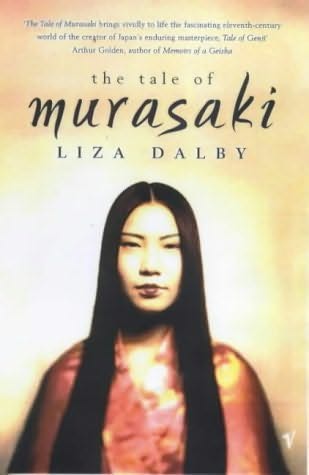This book has been sitting in my stash of books that I pick up cheaply through summer (from the boot markets) and then read whenever I am in need of some distraction. Seeing as I have moved from the office that had a library next door and also because my husband is heartily sick of paying my never-ending library fines, I thought I had best resort to the stash for a while.
After having read Memoirs of a Geisha by Arthur Golden and Mineko Iwasaki’s Geisha of Gion, I wasn’t expecting anything too different (hence why it has sat on the pile for so long). In fact this book was not at all about Geisha’s or their customs, although there was still plenty about kimono’s.
The book is an account of the life of Murasaki Shikubi, the eleventh century court lady and writer of one of Japan’s greatest literary works – The Tale of Genji. Dalby uses Murasaki’s diary and poetry and other work from the time as we follow Murasaki from her childhood, through her years as a literary spinster and her comparatively late marriage at the age of 25. We see her achieve fame and position as her stories of Genji, the “Shining Prince” become increasingly popular and she becomes a lady of the royal court. Dalby also describes her pain at leaving her child and the melancholy that plagues her throughout her life.
The book starts off feeling fairly traditional with an outline of Murasaki’s childhood and upbringing, the loss of her mother and her forays into bookishness. Beyond this though we find what makes this book so unique. I was astonished at the level of research and painstaking detail which went into this book. The detail in which the great houses, stunning gardens, ceremonies and court life of eleventh century Japan are described is amazing.
Iwasaki’s “Geisha of Gion” describes at length the importance, value and art of kimono. This book reinforces the value that these garments have for the Japanese. Murasaki describes in detail the different types of Kimono, the way they are layered, the way colour schemes are inspired by seasons and the subtle line between elegance and tackiness.
She also goes into details about the various arts that noble or courtly ladies specialised in: perfume making, painting, special family recipes, religious ceremonies and poetry. In fact the book includes many of the original short poems or Waka (precursors to the modern Haiku) written by Murasaki in the eleventh century.
Despite the beautiful and detailed descriptions and the insight into court life and the life of women in medieval Japan, the book can get bogged down at times. Murasaki is very analytical of others but also very critical of herself. Early in her life the writer falls into a depression of sorts which plagues her throughout her adult life.
This book also feels a little too long. At some point after Murasaki enters court life, nothing much further happens, so we are regaled with details of life in the royal palaces, minor scheming and gossip and mainly Murasaki’s gloom. I also found the ending abrupt. I knew what was coming, but after all the sadness and the minutiae of everyday life, we suddenly find the book at its conclusion. After the Tale of Murasaki, we find at the end of the book a translation one of the famous Tales of Genji. But to be honest, by this point, despite having enjoyed learning about Japanese culture, I was too bored to carry on.
After having read Memoirs of a Geisha by Arthur Golden and Mineko Iwasaki’s Geisha of Gion, I wasn’t expecting anything too different (hence why it has sat on the pile for so long). In fact this book was not at all about Geisha’s or their customs, although there was still plenty about kimono’s.
The book is an account of the life of Murasaki Shikubi, the eleventh century court lady and writer of one of Japan’s greatest literary works – The Tale of Genji. Dalby uses Murasaki’s diary and poetry and other work from the time as we follow Murasaki from her childhood, through her years as a literary spinster and her comparatively late marriage at the age of 25. We see her achieve fame and position as her stories of Genji, the “Shining Prince” become increasingly popular and she becomes a lady of the royal court. Dalby also describes her pain at leaving her child and the melancholy that plagues her throughout her life.
The book starts off feeling fairly traditional with an outline of Murasaki’s childhood and upbringing, the loss of her mother and her forays into bookishness. Beyond this though we find what makes this book so unique. I was astonished at the level of research and painstaking detail which went into this book. The detail in which the great houses, stunning gardens, ceremonies and court life of eleventh century Japan are described is amazing.
Iwasaki’s “Geisha of Gion” describes at length the importance, value and art of kimono. This book reinforces the value that these garments have for the Japanese. Murasaki describes in detail the different types of Kimono, the way they are layered, the way colour schemes are inspired by seasons and the subtle line between elegance and tackiness.
She also goes into details about the various arts that noble or courtly ladies specialised in: perfume making, painting, special family recipes, religious ceremonies and poetry. In fact the book includes many of the original short poems or Waka (precursors to the modern Haiku) written by Murasaki in the eleventh century.
Despite the beautiful and detailed descriptions and the insight into court life and the life of women in medieval Japan, the book can get bogged down at times. Murasaki is very analytical of others but also very critical of herself. Early in her life the writer falls into a depression of sorts which plagues her throughout her adult life.
This book also feels a little too long. At some point after Murasaki enters court life, nothing much further happens, so we are regaled with details of life in the royal palaces, minor scheming and gossip and mainly Murasaki’s gloom. I also found the ending abrupt. I knew what was coming, but after all the sadness and the minutiae of everyday life, we suddenly find the book at its conclusion. After the Tale of Murasaki, we find at the end of the book a translation one of the famous Tales of Genji. But to be honest, by this point, despite having enjoyed learning about Japanese culture, I was too bored to carry on.
































No comments:
Post a Comment